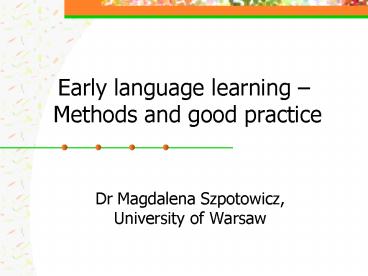Early language learning Methods and good practice - PowerPoint PPT Presentation
1 / 14
Title:
Early language learning Methods and good practice
Description:
Through the method - activity-based learning ... One person responsible for primary curriculum and FL development: - clear advantages ... – PowerPoint PPT presentation
Number of Views:146
Avg rating:3.0/5.0
Title: Early language learning Methods and good practice
1
Early language learning Methods and good
practice
- Dr Magdalena Szpotowicz, University of Warsaw
2
Areas to consider
- Children as eager learners
- Children as language learners (L1)
- Children as foreign/second language learners (L2)
- How do projects fit in this?
3
Integration of FL and the primary curriculum
- Through the topic - topic-centred learning
- Through the method - activity-based learning
- Through the teacher generalist/classroom
teacher of FL - Through CLiL (Content and Language Integrated
Learning)
4
Topic-centred learning
- context language learning takes place in
context to fit into childrens experience, new
words or sentences are part of a wide situation - meaning topic relevant to childrens experience
and interests is also meaningful and challenge
students to explore them further - purpose the above two create a genuine purpose
for using the language to use knowledge of
different areas (cross-curricular way).
5
Activity-based learning
- Develops cognitive abilities, e.g. describing,
identifying and recognizing, matching - Uses open-ended activities
6
Primary teacher and language
- One person responsible for primary curriculum and
FL development - - clear advantages
- - some problems
7
CLIL (Content and Languge Integrated Learning)
- Soft CLIL (cross-curricular teaching)
- Hard CLIL (bilingual education)
8
Project as a teaching method
- A project can be called a teaching method if it
- has a complex nature
- reaches beyond the existing organisational forms
and procedures - has its own unique character
- introduces changes
- takes place within defined time
- accomplishes specific aims
- consists of pre-planned phases
- uses defined means and resources
- is constantly monitored and evaluated
9
How does project work fit into primary curriculum?
- Promotes discovery
- Encourages the production of concrete outcomes
- Promotes creativity (learners and teachers)
- Encourages using extra resources
- Promotes independent outside school work
- (the difficulty for the teacher of doing all in
class and balancing autonomy to reasonable
degree)
10
Projects not at once
- Before you start a long-term project, get the
students familiar with the most typical
techniques used in this method - Working in pairs or groups
- Searching for information
- Producing language-related materials
- Presenting own work in front of others
- Evaluating and self-evaluating
11
Aim setting
- Project-based teaching is very effective in
attaining the aims referring to students - cognitive development
- emotional development
- motivation
- active involvement and ownership
12
Projects with children and older learners
- The main difference between language projects
with children and older learners is in the degree
of learner autonomy and the amount of work they
are able to do independently or outside the
classroom.
13
Projects with children
- The teacher
- responsible for decision-making in more areas
- closer monitoring of work
- more frequent reviewing of plans
- planing more and shorter stages
- less flexibility with staging of the final
product - Less L2 communication with learners
14
FL progress in YL projects
- It is easy to lose the opportunity of teaching
and communicating in L2 while doing projects with
children who speak little English (or other FL). - Every phase of the project should incorporate an
element of language presentation or practice. - Every phase should be evaluated for its language
development usefulness.































